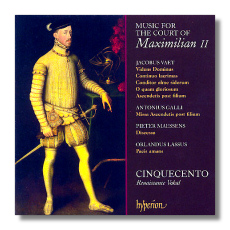
The Internet's Premier Classical Music Source
Related Links
- Latest Reviews
- More Reviews
-
By Composer
-
Collections
DVD & Blu-ray
Books
Concert Reviews
Articles/Interviews
Software
Audio
Search Amazon
Recommended Links
Site News
 CD Review
CD Review
Music for the Court of Maximilian II

- Jacobus Vaet (c.1529-1567)
- Videns Dominus
- Conditor alme siderum
- O quam gloriosum
- Ascendetis post filium 'In laudem Invictiss. Rom. Imp. Max. II'
- Continuo lacrimas 'In mortem Clementis non Papae'
- Antonius Galli (c.1505?-1565): Missa Ascendetis post filium
- Pieter Maessens (1505-1563): Discessu
- Orlandus Lassus (1532?-1594): Pacis amans
Cinquecento
Hyperion CDA67579
Maximilian II was Holy Roman Emperor from 1564 to 1576. His father, Ferdinand, had established a chapel at court by 1529 and Maximilian, a Habsburg in Austria, followed the tradition and engaged Jacobus Vaet (ca. 1529-1567) as Kapellmeister by 1554 when the composer was still remarkably young. Vaet would surely have been better known (today) had he not died so soon: he produced nine mass settings (including a Requiem mass), over sixty motets, a set of Magnificats, several chansons and sundry liturgical pieces. His Ascendetis post filium motet is a good example of the "state motet"; these were written to praise (royal) patrons, in this case the Habsburgs. Vaet's music is withdrawn, self-aware, doleful at times; but neither excessively introspective, nor turgid. Cinquecento's singing is well-suited to such a tone: they deal with the slower, more extended vowels most effectively and negotiate the at times somewhat sibilant lines with grace.
Vaet's Ascendetis post filium is the motet on which Antonius Galli's (c.1505?-1565) mass is based. This wonderful mass is the longest work on the CD and represents a significant portion of Galli's entire output: he is only known to have composed a handful of chansons and three "parody" masses, of which this is one… imitative, based on an existing motet. It too is a slow and "deliberate" work. Listen to the mournful "Kyrie" with some of the qualities of a dream, moving slowly and barely making an impact on the world, on which it yet so totally relies. That, convincingly, is how Cinquecento present it. No fuss, no undue emphasis on its heights and depths. Yet it's all the more impressive for their holding back as they feel their way through the music. Their performance – listen to the Gloria – has a particularly effective mix of majesty, magnificence and intimacy. Pretty much how you would expect and have wanted a contemporary performance to have sounded. This Mass is perhaps the high-point of this disc; the Credo, for instance, is a movement of ethereal beauty, intensely personal and low key but with a conviction – given the parallel dedication and careful drive of Cinquecento – that lends this highly colored work such power and feeling.
It seems probable that Pieter Maessens (1505-1563) facilitated Vaet's appointment, having worked as magister cantus at Notre Dame before moving to Ferdinand's chapel. He began life as a soldier in the service of Charles V, was dismissed for neglecting his musical duties (and heavy drinking) after taking holy orders and by the time he was working for Ferdinand. Maessens' work is as colorful as his life but without what one might have imagined would be an attendant roughness – the Discessu uses the same soggetto carato as developed by Josquin in his "Missa Hercules Dux Ferrarie" where the vowels of the name of his patron, Maximilian, are rendered into solmization syllables… "fa-mi-mi-mi-fa-ut": a verbal puzzle; though perhaps it's the double canon rather than this conceit that carries Maessens piece.
Although not a member of the Maximilian court, Lassus (1532?-1594) worked for the Dukes of Bavaria, who had a close relationship with the Habsburgs and music was often exchanged between the two centers. Probably the most widely-known setter of text in the sixteenth century, his "Pacis amans" is a splendid and thoughtful dish of intricately-woven, sometimes chromatic waxing and waning harmonic melodies – written, in fact, in celebration of Maximilian's crowning in 1562 as King of Bohemia. Cinquecento ascend this little peak without a tremor.
Maximilian's chapel expanded considerably and most likely consisted eventually of seventy singers. The impression is of a lively, culturally vibrant and attractive place for musicians to work in. Such an atmosphere of integrity and earnestness is conveyed in this elegant, restrained recording of works varying in length from just over two to nearly 34 minutes. There is contrast; there is a sense of infinite care in the singing without its ever becoming "precious" or studied. This is surely due as much to the origins of the music itself as to the extent to which it's fresh and still being intelligently explored – a good and musicianly thing – by Cinquecento, who have all the accomplishment and polish needed to make this a memorable contribution to the catalog of some of the still unexplored areas of sixteenth century choral music.
Cinquecento (It., "sixteenth century") was formed in 2004 in Vienna as a six-person all male pan-European group whose aims are chiefly to bring to wider attention the lesser-known sixteenth century choral composers associated with the Austrian courts and, more generally, to expose the vast range of compositional polyphonic styles across the rest of Europe in the period. With members from present day Austria, Belgium, England, Germany and Switzerland, this is their first recording; it bodes very well for them!
Copyright © 2007, Mark Sealey




















